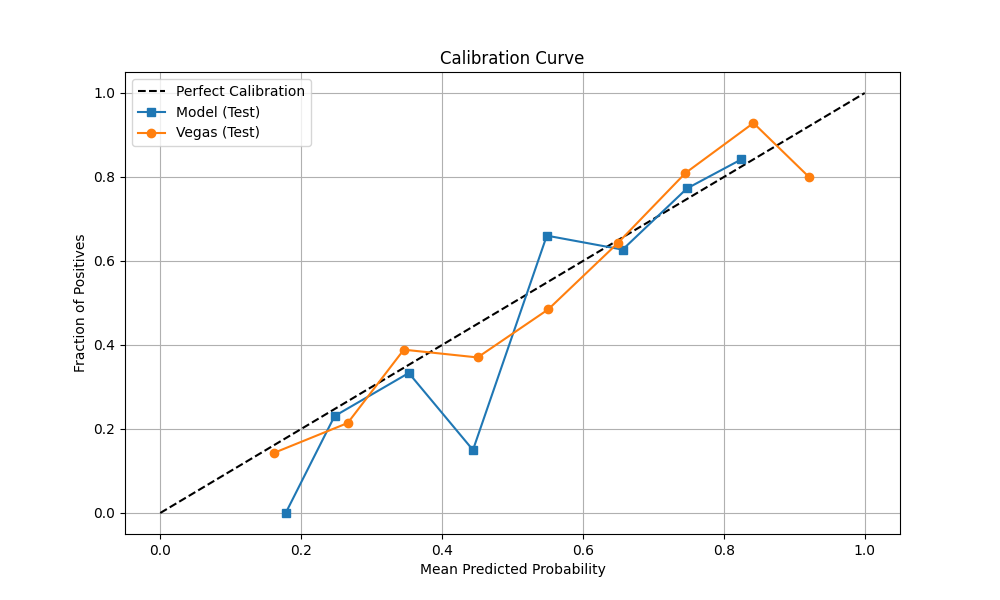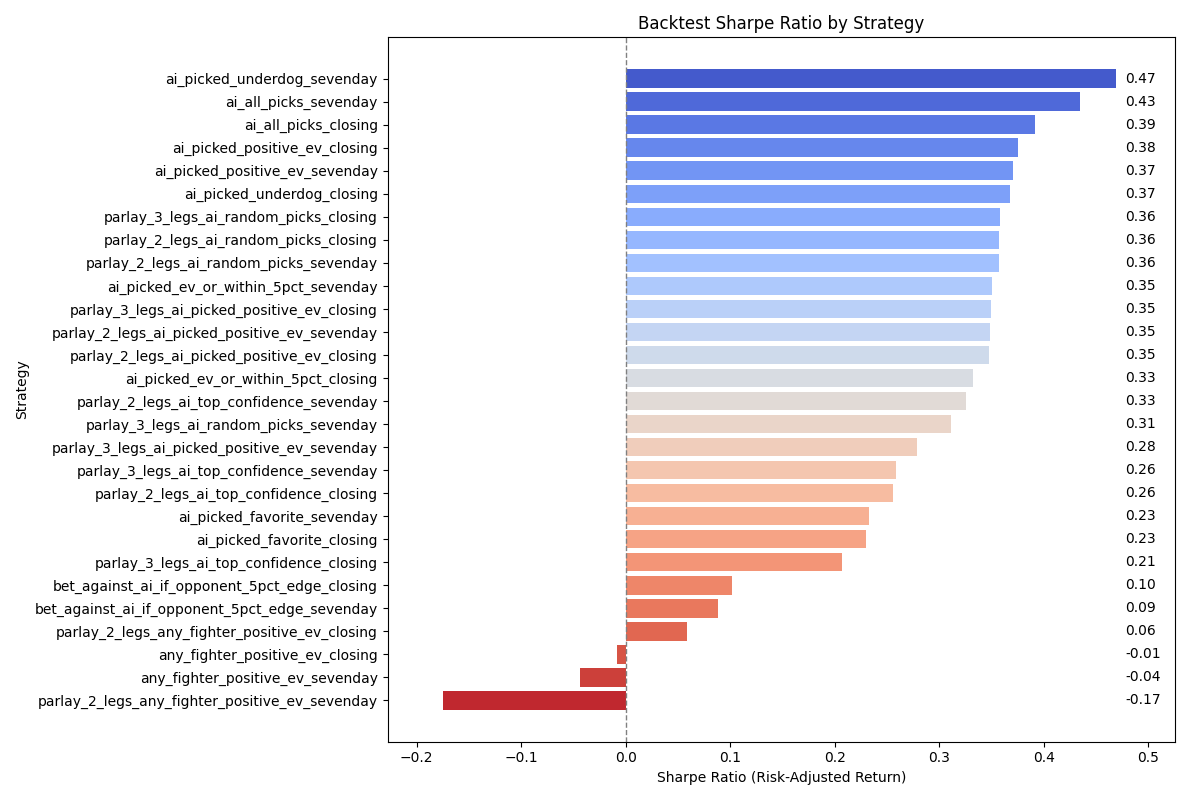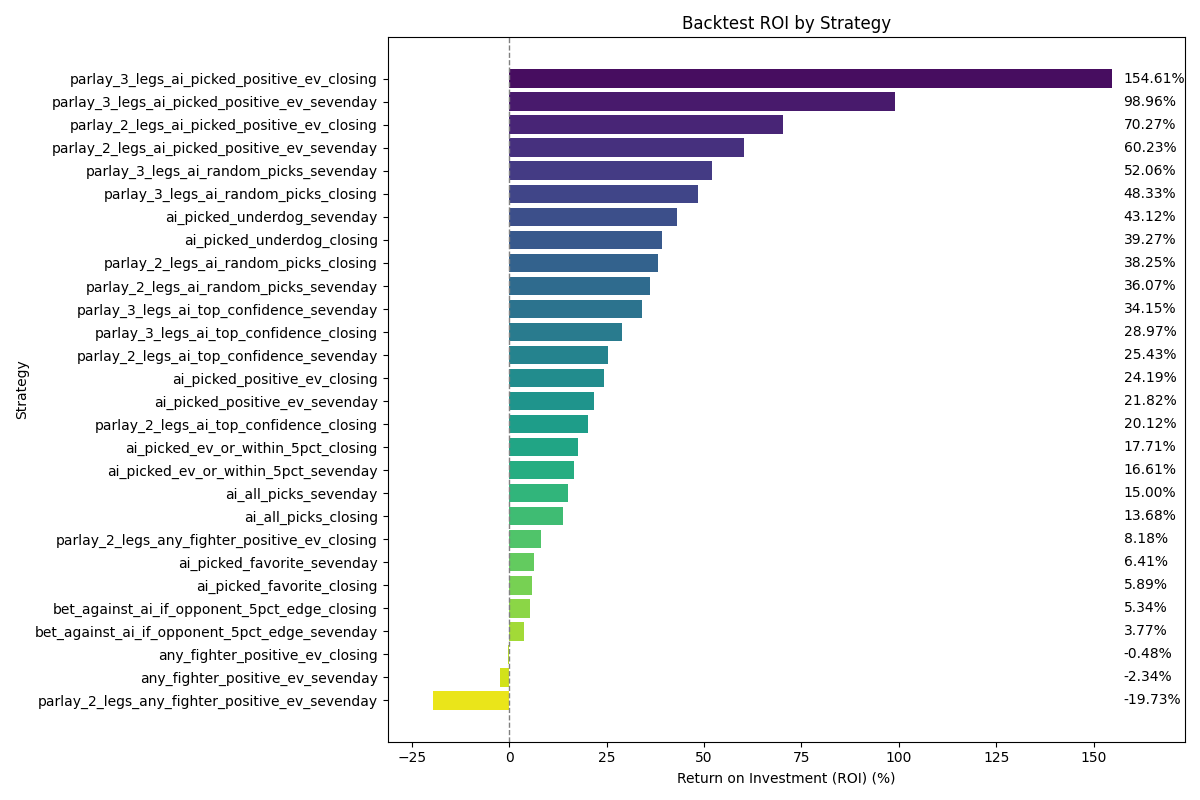MODEL.details
Performance metrics on the last year of fights (data not used in model training)
Vegas Odds Performance
| Accuracy | 69.05% |
| Precision | 0.725 |
| Recall | 0.725 |
| F1 Score | 0.725 |
| Log Loss | 0.587 |
| Brier Score | 0.201 |
MMA-AI.net Performance
| Accuracy | 71.03% |
| Precision | 0.697 |
| Recall | 0.859 |
| F1 Score | 0.770 |
| Log Loss | 0.602 |
| Brier Score | 0.207 |
| Feature | Importance |
|---|---|
| Age Decayed Average Difference | |
| Significant Strike Landing Ratio Decayed Adjusted Performance Decayed Average Difference | |
| Reach Ratio Decayed Average Difference | |
| Submission Attempts Decayed Average Difference | |
| Takedown Accuracy Decayed Average Difference | |
| Head Landing Decayed Average Difference | |
| Age Ratio Difference | |
| Head Defense Decayed Average Difference | |
| UFC Age Decayed Average Difference | |
| Head Landing Ratio Decayed Adjusted Performance Decayed Average Difference | |
| Distance Accuracy Decayed Adjusted Performance Decayed Average Difference | |
| Body Accuracy Decayed Adjusted Performance Decayed Average Difference | |
| Significant Strike Landing Ratio Decayed Average Difference | |
| Knockout Decayed Average Difference | |
| Body Defense Decayed Average Difference | |
| Ground Defense Decayed Adjusted Performance Decayed Average Difference | |
| Leg Landing Per Minute Opponent Decayed Average Difference | |
| Control Round 1 Decayed Average Difference | |
| Win Ratio Decayed Average Difference | |
| Clinch Landing Per Minute Decayed Average Difference | |
| Days Since Last Fight Decayed Average Difference | |
| Takedown Defense Decayed Average Difference | |
| Control Round 1 Per Minute Opponent Decayed Average Difference | |
| Head Accuracy Decayed Adjusted Performance Decayed Average Difference | |
| Reversals Round 1 Ratio Opponent Decayed Average Difference | |
| Distance Defense Decayed Adjusted Performance Decayed Average Difference | |
| Submission Attempts Per Minute Opponent Decayed Average Difference | |
| Strikes Landed Round 1 Decayed Adjusted Performance Decayed Average Difference | |
| Reversals Decayed Adjusted Performance Decayed Average Difference | |
| Distance Landing Ratio Decayed Adjusted Performance Decayed Average Difference | |
| Knockdown Opponent Decayed Average Difference |

This curve shows how well the model's predicted probabilities align with actual outcomes. The closer to the diagonal line, the better calibrated the predictions.
Sharpe Ratio by Strategy

The Sharpe Ratio measures the performance of an investment compared to a risk-free asset, after adjusting for its risk. Higher values indicate better risk-adjusted returns.

ROI by betting strategy. See the News page for "Why Don't You Recommend The Positive EV Picks?" for a detailed explanation and interpretation of these results.
Frequently Asked Questions
When do you post predictions?
I try to get them up as soon as the previous event is over.
How long have you been doing this?
About 4 years. Thousands and thousands of hours tuning, testing, and engineering. At this point I can absolutely chat your ear off about the intricacies of machine learning for sports prediction.
What is your background?
I was a hacker for about 15 years, now I'm an AI security researcher and engineer.
Where do you get the data?
Downloaded from various MMA stat sites. We start with 22 base stats like Strikes Landed and engineer those into 20,000+ stats. Then we cut those down to about 30 of the most influential, predictive stats based on both manual expertise and statistical analysis.
What is the betting strategy you use?
Personally I use 2-3 leg parlays on the +EV AI picks.
Why is this free?
IDK why not.
Why don't you just pick the +EV fights?
This is a binary classification algorithm. It is excellent at picking the winner, and not so good at creating realistic confidence scores. I have experimented with lots of calibration techniques but the results are worse than just doing +EV on the AI picks.
What algorithm do you use?
I use an ensemble of traditional machine learning algorithms. Gradient boosted algorithms, neural networks, tree-based algorithms, and others. This is not an LLM tool, there is no ChatGPT here although I am exploring that as well.
What was the hardest part of this project?
Feature engineering but especially feature selection. This is what separates MMA-AI.net from all other MMA prediction tools (besides wolftickets.ai who helped me with this part). First, more features =/= better results. Second, feature selection is an art that is dependant on domain expertise and ENDLESS testing.